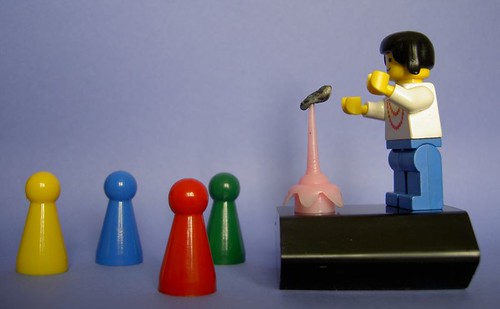A Conference Peer Discussion Manifesto
For too many years, our conference education and experiences have been one-way, from the speaker’s mouth to the listener’s ear.
Attendees are like pawns in the speaker’s (faux) control.
This passive, inactive experience has led to the myth that experts have knowledge that they can give to attendees through their presentations and then attendees have it. (How often have you walked away from a presentation and now have the speaker’s expertise complete with an understanding of how to apply it?)
It’s just not how our brains process and retain important information. If it were true, then our world would be a very different place because of all the sermons that occur every Saturday and Sunday. We would be a changed society.
Peer Discussions Should Rule!
Dialogue is critical to enhance and augment individual and team learning. It forces new ways of viewing one’s assumptions and creates a way for adults to deal with the complexity of change, disagreement and disruptive innovation.
Peer to peer discussion about specific conference content is one method to align the conference experience with how our brains learn. This two-way colleague communication allows participants to process information, ask questions, receive feedback and test ideas.
But what percentage of conference education sessions actually use peer discussions? (No, we are not talking about question and answer with the speaker here!)
Our conferences should be like hives buzzing with chatter between participants. Education sessions should not be silent venues with only monologues or panel dialogues. They should be alive with energy.
Conference Peer Discussion Manifesto
Conferences that embrace participant learning over information transfer foster peer dialogue that adopts the following actions:
- Regards one another as professional colleagues.
- Supports “Subject Matter Experienced” (SME) over subject matter experts.
This is a belief that every participant walks into a conference session with some type of experience or previous knowledge of the content being presented and should have the chance to share their thoughts. - Shelves bulk learning in the name of intention.
- Practices techniques of adult dialogue that suspend emotional hijacks and prevents defensiveness, smoothing over and competitiveness.
- Embraces conflict and tension as a resource rather than a negative.
- Adopts a spirit of inquiry.
- Slows down inquiry by implementing time for personal reflection and contemplate exercises.
- Acknowledges that the only one who can control learning is the learner, not the speaker who controls the information flow.
- Embraces feedback from peers through discussion as a crucial part of learning.
- Sees failure as part of the learning process.
- Suspends assumptions and certainties.
- Practices “unlearning” as a necessary part of learning.
- Observes the observer and discussed how to improve observation, listening and communication skills.
- Embraces peerology.
What keeps conference organizers from implementing more peer discussions in conference education sessions? What concerns do you have about putting into practice the conference peer discussion manifesto?



Jeff
Great manifesto and ideas for changing the status quo of meetings to actually leave people with a richer experience, and indeed more contextual information at the end of a meeting. I continue to find it fascinating how many organizations of all kinds are still stuck on using one way discussion to deliver learning. We can only foster change one meeting at a time, so keep sharing the great ideas.
Our conference evals confirm that our delegates want more time for discussion and fewer presentations. Our problem is that 80% of our attendees are also presenters, and many of them must be listed as a speaker on the program in order to get funding to attend from their companies. It is a 3.5 day conference, so short of adding another 1-2 days to the total event, it is challenging to increase discussion time without significantly decreasing the number of presenters.
‘@Tahira – thanks as always for reading and commenting. We appreciate your candor.
@Bridget – You illustrated a common challenge for some conferences. They have become conferences of speakers speaking to speakers and the conference success has become dependent upon those speakers. This is really backwards as conferences are for paying attendees, not speakers.
Unfortunately, this is also a barrier for your growth. If 80% of your audience are speakers, you have already put parameters on your conference and for some reason you are not attracting others outside of speakers. Unfortunately, we’ve seen other conferences that have a similar problem that continue to decline as their true opportunity for growth lies beyond attracting people they can only come if they present. It’s hard and courageous work to change this direction and requires a detailed analysis of your current customer and potential market as well as an analysis of your programming. You have to intentionally program content/learning opportunities differently to that you start attracting a different audience.
Thanks for reading and commenting. Here’s to your continued conference success.
This should be considered at all meetings. Actually when I facilitate a retreat the sharing of best practices and getting input from everyone creates great value. Actually, when I go to a conference, I find that the meetings in the hall on a one to one basis with my peers creates the best value.
Great post! This is something a talk about at length with our corporate clients when organising their conferences – everyone (organisers, speakers & delagates) wants greater audience interaction and knowledge takeaway but corporate organisers are afraid to break the mold of the traditional/safe conference format and try something new.
Would love to hear more on this and some examples of how to implement this approach in practice.
[…] A Conference Peer Discussion Manifesto […]